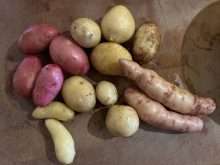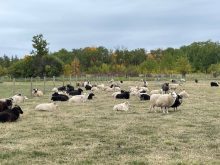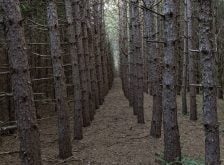The word “sustainable” has become one of the most misused words in agricultural information systems. What we have to realize on Canada’s Prairies is that “sustainable” really means farmers maintain the status quo for good, achievable, economic agricultural practices on their cropland.
What may be sustainable agricultural systems for Eastern Canada or the north-central United States may be fully unsuitable for the Canadian Prairies. Catch crops or cover crops are logistically unsuitable for the short-season Prairie climate following harvest in late August or September, particularly in dry years. This leaves little or no time for cover crop or catch crop establishment before fall freeze-up in October. Added to this is that even if a catch crop (that is, an under-seeded legume in a cereal crop) were to establish by September, there would be a loss of moisture for the following season’s crop. In southern Ontario, when a cereal crop is removed in late July and rainfall is normally higher, a cover crop may have up to three months of growth and could contribute significantly to the soil organic content and nitrogen levels if a legume is present. This same type of situation can exist in the U.K. and the central states of the U.S., where cover and catch crops can have three to four months or more for establishment prior to winter’s onset, along with usually much higher rainfall levels.
Read Also

Cancer agency reclassifies another herbicide ‘probably carcinogenic’
The WHO’s cancer research agency has now put atrazine, a herbicide well known to corn growers, in the same potential-hazard category where the agency put glyphosate.
Looking at agricultural producers on the Prairies, particularly in central Alberta, I see many farms believe they are abiding by sustainable systems but far too many are way out of line. They are in fact slowly degrading their cropland farms as they have for the past 100-200 years.
It’s hard to explain why well-intentioned farmers growing cereal and canola crops, particularly on sandy or sandy loam soils, continue to bale up and sell the resulting cereal straw. Why would such farmers sell up to two tons of cereal straw per acre, often at below input recovery cost?
A 1,000-lb. straw bale at four bales per acre would, along with the cost of baling, field transport and nutrient level, be valued at $40 per bale in straw nutrients and baling costs. Nothing is mentioned about the removal of two tons of organic matter per acre. What if the farmer had used a straw chopper instead of a baler? I did write an article in Grainews entitled “16 reasons why farmers shouldn’t sell a bale of straw.” I can add more reasons: soil compression or compaction, especially on more clay-type soils from the very heavy bale trailers, and movement of soil-borne diseases such as clubroot and pea root rot and of noxious and herbicide-resistant weeds from farm to farm when bale transporters pick up bales. Movements from field to field, especially under muddy fall conditions, are ripe for spreading weeds and diseases — not to forget that transporting a full load of bales to any destination costs $200 to $350 an hour.
How many farm fields have I seen this fall with clean powder-like soil looking just ready for canola seeding that could be done this past October? Is this just recreational tillage since farmers removed their crops early this year? In central Alberta I have seen dry April and early May weather when such overworked fields produce enough dust for highway blackouts. The soil has been unnecessarily dried out; the crop stubble which would trap snow and allow for much easier soil water penetration has been removed.
Some people think “organic farming” is the solution for sustainable farming. In reality this is far from it, since organic farmers underproduce crops nationwide and rely on tillage and fallowing for weed control, causing soil drying and further depletion of organic matter.
Thinking back some 150-200 years ago, Prairie soils from Manitoba to the B.C. Peace region had anything from two to 10 per cent organic matter. Farming over 100 or so years ago was virtually organic. Little if any fertilizer was applied to the soil and pesticides were unheard of. Fallowing the land for one or more seasons was the only form of weed, disease or even insect control.
As a consequence, organic levels in most Prairie cropland fell by as much as 50 per cent or more. The soil organic fraction at one per cent organic contains 10,000 lbs. of carbon, 1,000 lbs. of nitrogen and100 lbs. of sulphur as well as reserves of hundreds of pounds of phosphate and perhaps a pound or so of boron. Potassium (potash) is part of the mineral content of the soil. So, if you do the math, think of the nitrogen that has been removed from cropland that went from 10 per cent to five per cent organic. It amounts to removal (or loss) of 5,000 lbs. of nitrogen per acre over time — that’s 800,000 lbs. of N or thereabouts per quarter section, or again, 400 tons of fixed nitrogen. Not to forget that under Prairie growing conditions, nitrogen release from organic matter is around one per cent of the organic matter per growing season. A five per cent organic matter cropland in most seasons could release up to 50 lbs. of crop-available nitrogen. That, without amendment of bagged fertilizer, would be enough for a 25- to 30-bushel crop of wheat. Many other Prairie soils started out with two to five per cent organic matter when they were first tilled and are now down by 50 per cent, to one to 2.5 per cent organic matter. Also just think of the 4,000 tons of organic matter per quarter section in that five per cent organic loss.
To get that 70- to 80-bushel crop of wheat, from a five per cent organic soil, you have to add at least 100 lbs. of nitrogen as well as likely substantial phosphate and sulphur. You will even have to pay attention to micronutrients such as zinc, copper, boron and manganese and molybdenum to obtain your expected yield, assuming moisture, disease, weeds or insects are not crop-limiting.
Crop residue should never or rarely be removed unless you are a cattle farmer who would return all and any manure back onto your cropland or return it to your cereal-growing neighbours.
Such stories as seeding your cropland in some years to these “magic” seed mixes that contain legumes, and cole crops such as turnips, are best forgotten since not only can they increase disease levels such as clubroot and pea root rot but they allow a proliferation of weeds with some, such as crown vetch, becoming persistent weed problems.
“Sustainable farming,” at least in my interpretation, involves maintaining the present status of your cropland, keeping your crop residues and adding the appropriate “balanced” level of crop nutrients (fertilizers), whether macro- or micro-nutrient, to obtain the yield that is afforded by your expected annual rainfall.
When you hear Canada is running out of cropland, please reply that less than six per cent of the country is actually cultivated land and say no more.
Cropland soils never need a rest; they just need adequate moisture and necessary nutrients, both macro- and micro-, to attain yield targets annually.
Scattered amongst those sandy fields that harvest straw in the Edmonton area are many seed potato growers as well as clients of the very successful Edmonton-based Little Potato Company. Potato growers rent suitable sandy land from cereal/canola growers on a biennial basis. For the first year they take over cereal land, either with chopped straw or straw removed or canola stubble fields. Potato growers do not work this potato cropland in the fall but leave the surface intact. They want the stubble to catch the snow and the in-situ stubble to allow for soil percolation of the snowmelt or rainfall. This objective is to build up a year’s supply of water (moisture) in the field that will be planted to potatoes the next year.
So, the potato cropland is planted to potatoes during May of the second year. It is by this second year of moisture-trapping that the central Alberta dryland potato growers can achieve yields of 15-24 tons of potatoes per year, primarily for seed potato production. A “little potato” crop yielding six to nine tons an acre in this area does not need the extra moisture and is usually planted directly into standing canola stubble in the spring. Just plain smart adaptive thinking by dryland Prairie potato producers.
















